Rich, natural wood, low-maintenance metal, integrated privacy drapes, and energy-saving solar roofs are all driving a fresh wave of gazebo-on-deck inspiration for 2025. Designers are layering decks on multiple levels for distinct “rooms,” adding floating foundations where soil is tricky, and pairing sleek rail-through glass with insulated roof panels so the same structure works from monsoon season through crisp winter evenings. Lighting has become more architectural—think moonlighting tucked high in rafters—while screens and sliding panels deliver instant seclusion without blocking airflow. Materials matter, too: modern powder-coated steel offers 30-year durability, whereas cedar provides a warm scent and easier DIY customization. All twenty ideas below translate these trends into practical, build-ready concepts.
1. Multi-Level Deck Gazebo Retreat
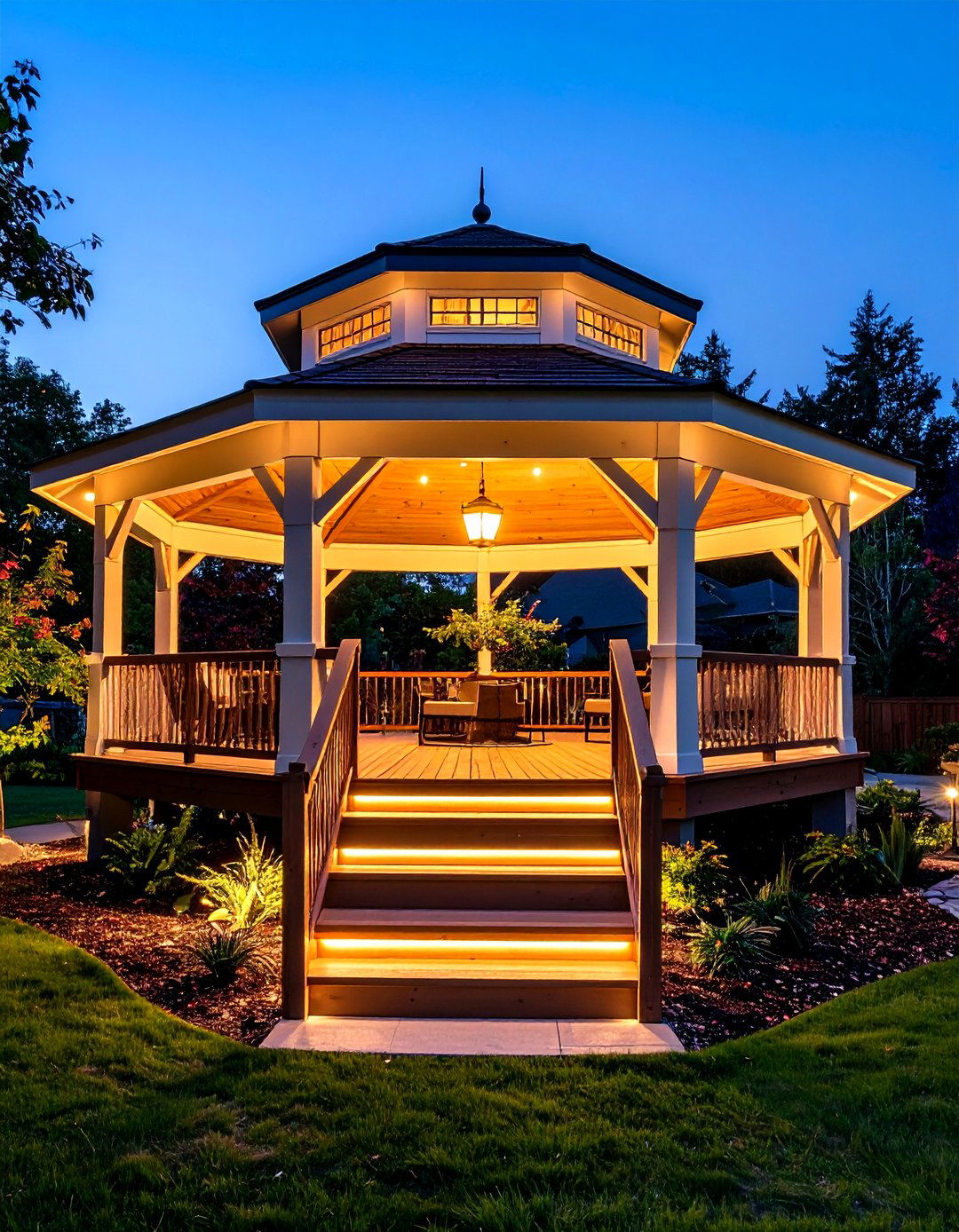
A multi-level deck capped by a gazebo instantly creates zones—dining on the upper tier, lounge seating below—while maintaining one cohesive footprint. Begin by framing staggered platforms so the gazebo occupies the highest level; the elevation maximizes airflow and delivers long vistas. Incorporate wide wraparound stairs to link levels smoothly, borrowing cues from professional photos of terraced decks that feel like natural hillside steps. Add subtle under-step lighting for nighttime safety and ambiance; uplights mounted at the gazebo’s posts mirror those tiers for symmetry. Finally, combine horizontal cable or glass railings to keep sightlines clean so every tier enjoys the gazebo’s shade and architectural focal point.
2. Compact Corner Gazebo for Small Decks
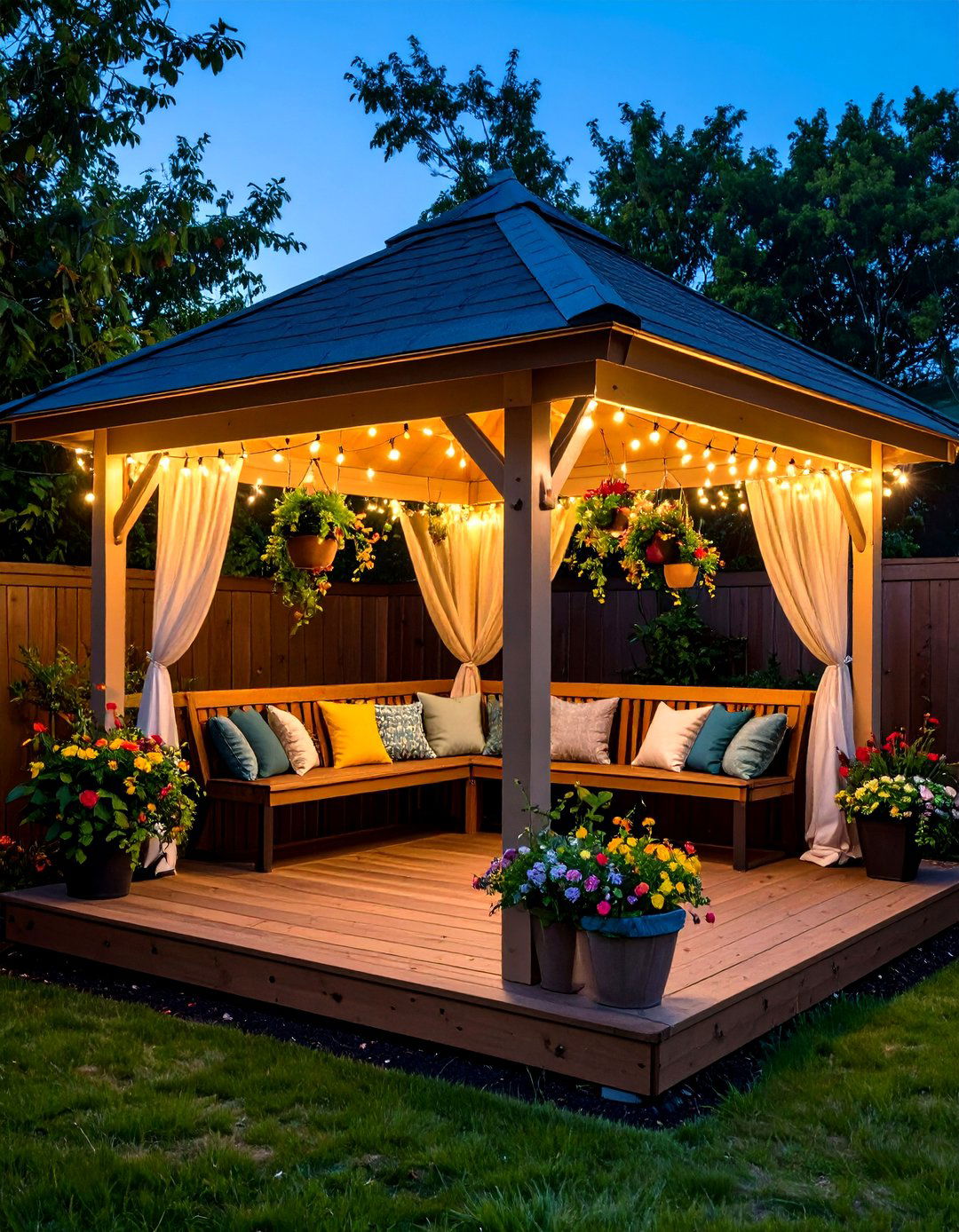
Unlike sprawling builds, a corner gazebo tucks neatly into a tight deck footprint while still delivering full shade. Opt for a hexagonal or square kit sized under 10×10 ft, anchoring two sides directly to existing rail posts to save material and preserve traffic flow across the planks. Swapping bulky corner rails for built-in bench seating doubles as space-savvy storage while subtly reinforcing the structure. Add hanging planters beneath the roof edge—this vertical greenery tricks the eye into feeling more room without widening the deck. Finish with string-light curtains that drape only the gazebo zone, creating intimacy without clutter.
3. Hot-Tub Gazebo Oasis on Raised Deck
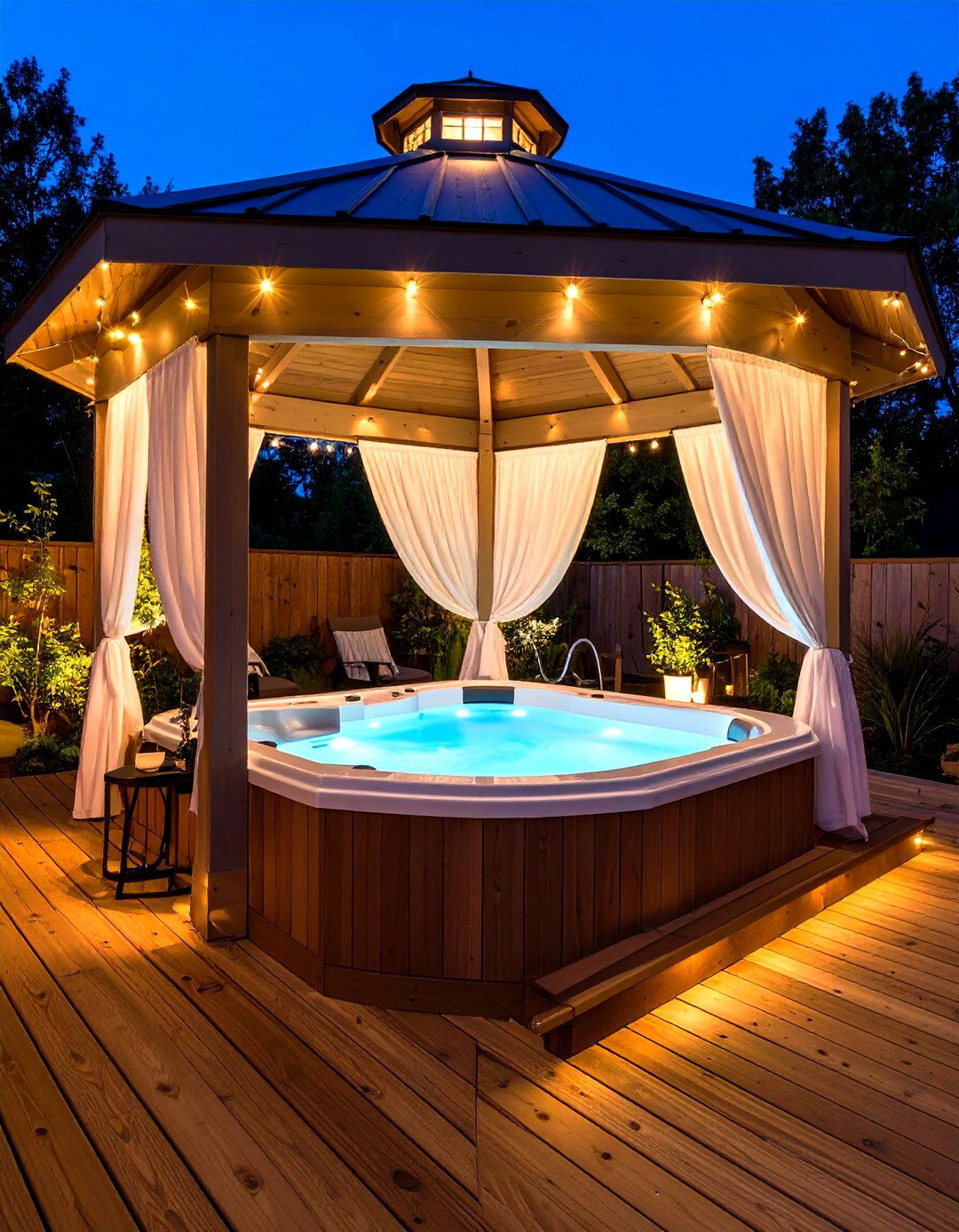
For a true spa vibe, recess a compact hot tub flush into the deck and set a ventilated gazebo overhead. Use moisture-tolerant composite decking to ring the tub; these boards resist chlorinated splash and require little upkeep. Choose a vented hard-top gazebo so steam escapes while roof panels shelter bathers from rain. Install dimmable LED strip lights under the gazebo rafters—warm lows for relaxation, bright highs for cleanup. Privacy curtains glide along hidden tracks, closing off the tub when needed and sliding fully back for stargazing soakers.
4. Panoramic Railing Gazebo for Scenic Views
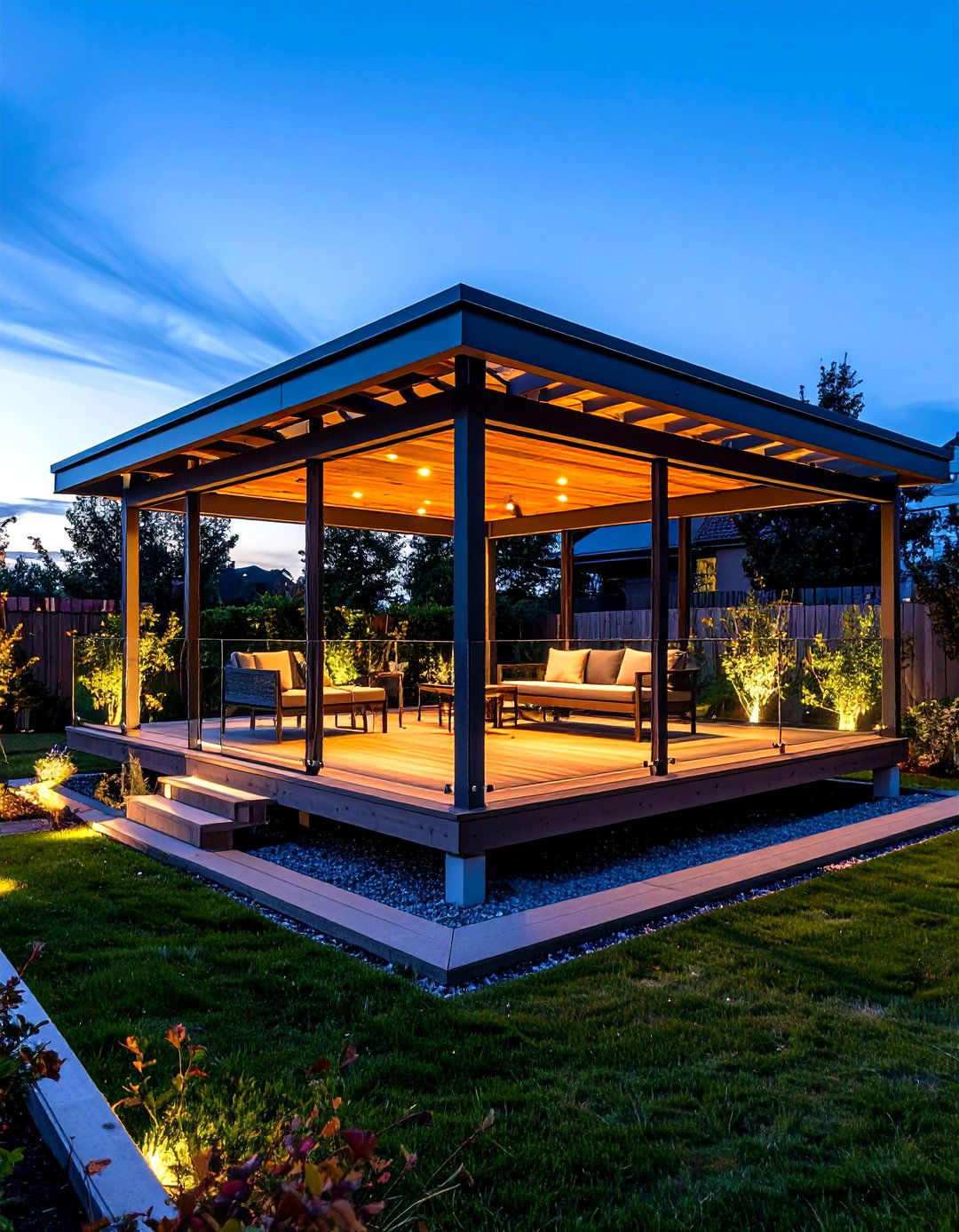
Perched on a bluff or overlooking a city skyline, this idea pairs an open-sided gazebo with transparent glass or cable railings so vistas remain uninterrupted. Position posts just inside the deck edge to prevent glare on the glazing. A low-profile metal roof in matte charcoal disappears against the horizon, while a single floating bench wraps the perimeter—reducing furniture clutter that might block the sightline. Twilight enjoyment comes from discreet downlighting tucked beneath the roof beams, recreating moonlight without visible fixtures.
5. Privacy-Screen Gazebo Shield
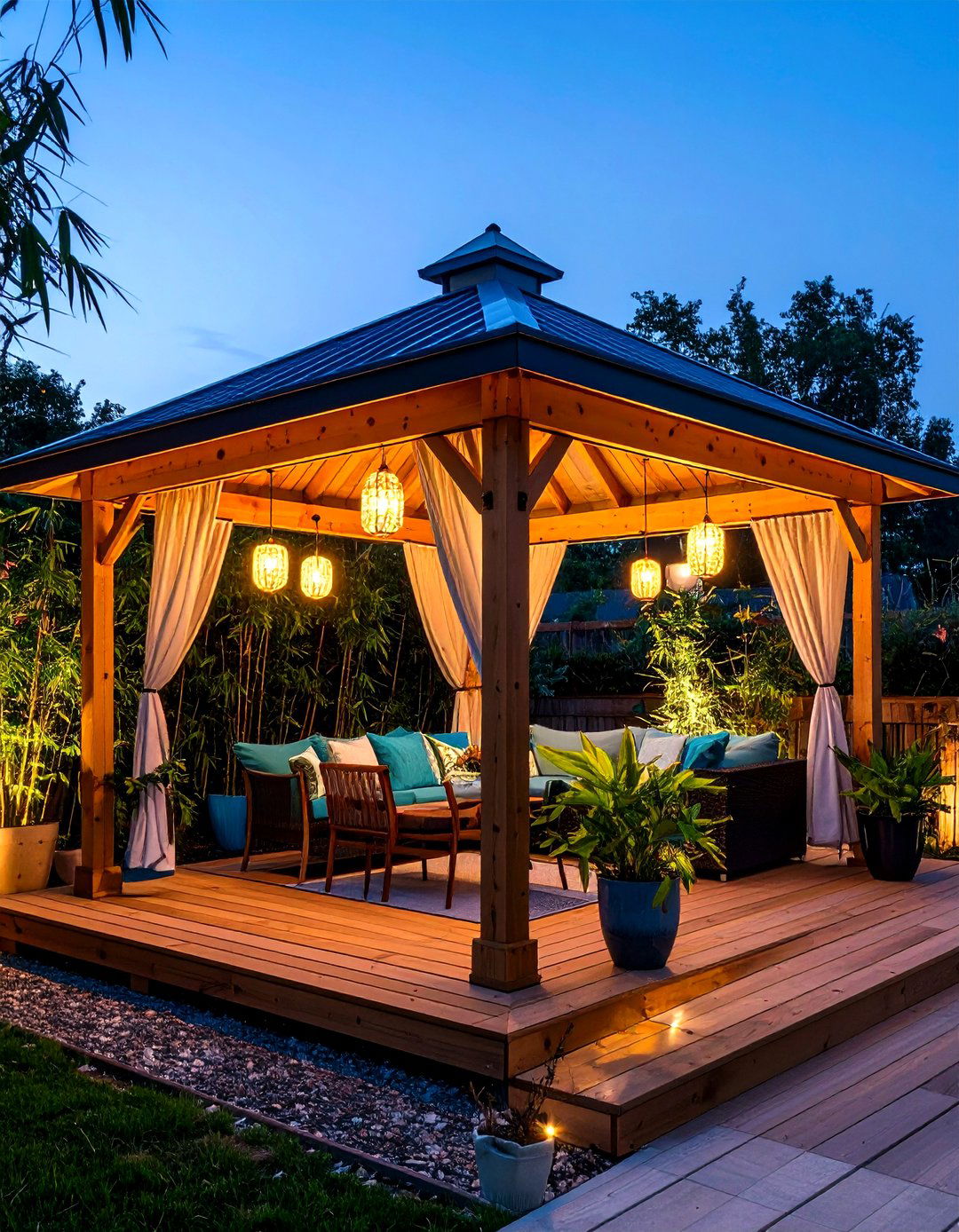
If neighboring houses loom, slide-track screens or clip-on fabric panels instantly transform an exposed deck gazebo into a private nook. Opt for polypropylene mesh rated to filter 90 % of UV rays while allowing breezes. Pair opposite wall panels with tall potted bamboo to soften hard edges. Interior pendant lights hung low inside the gazebo prevent silhouettes from projecting onto screens after dark, protecting privacy further. For flexibility, install the screens only on two sides, leaving the other faces open so the deck still feels airy when privacy isn’t required.
6. Durable Metal-Frame Gazebo for Strength
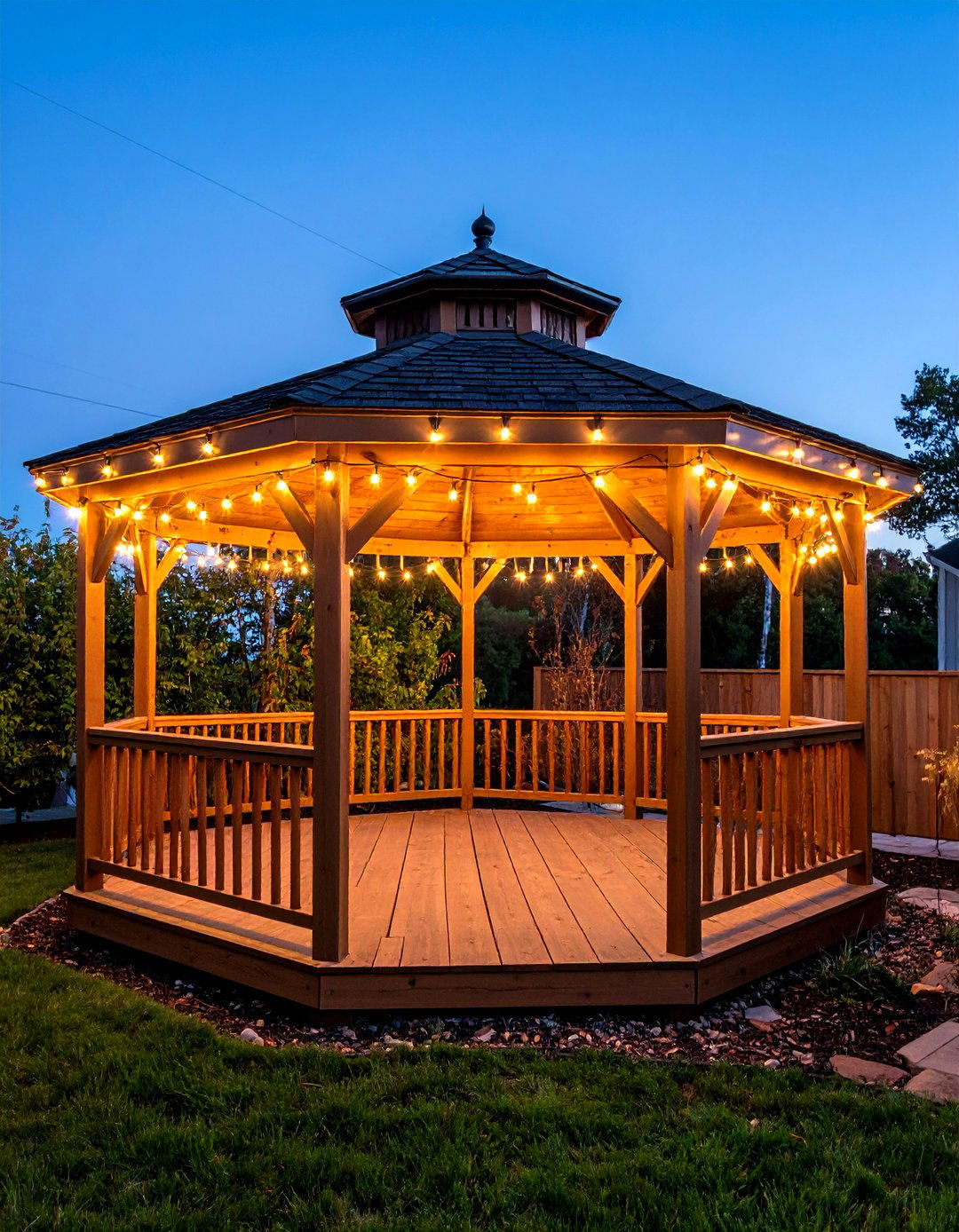
A powder-coated steel gazebo anchored to a deck’s joists resists rust, wind uplift, and termite damage far longer than basic pine. Because metal frames often arrive in modular panels, DIY installation can finish in a weekend—ideal when you want upgrades without a full contractor schedule. Hard-top steel roofs shrug off snow loads and channel runoff safely beyond deck edges. Finish the posts with snap-on cedar wraps for visual warmth, merging metal’s longevity with timber character. Solar string lights fed through built-in roof channels keep wiring hidden yet accessible.
7. Warm Cedar Wood Gazebo Charm
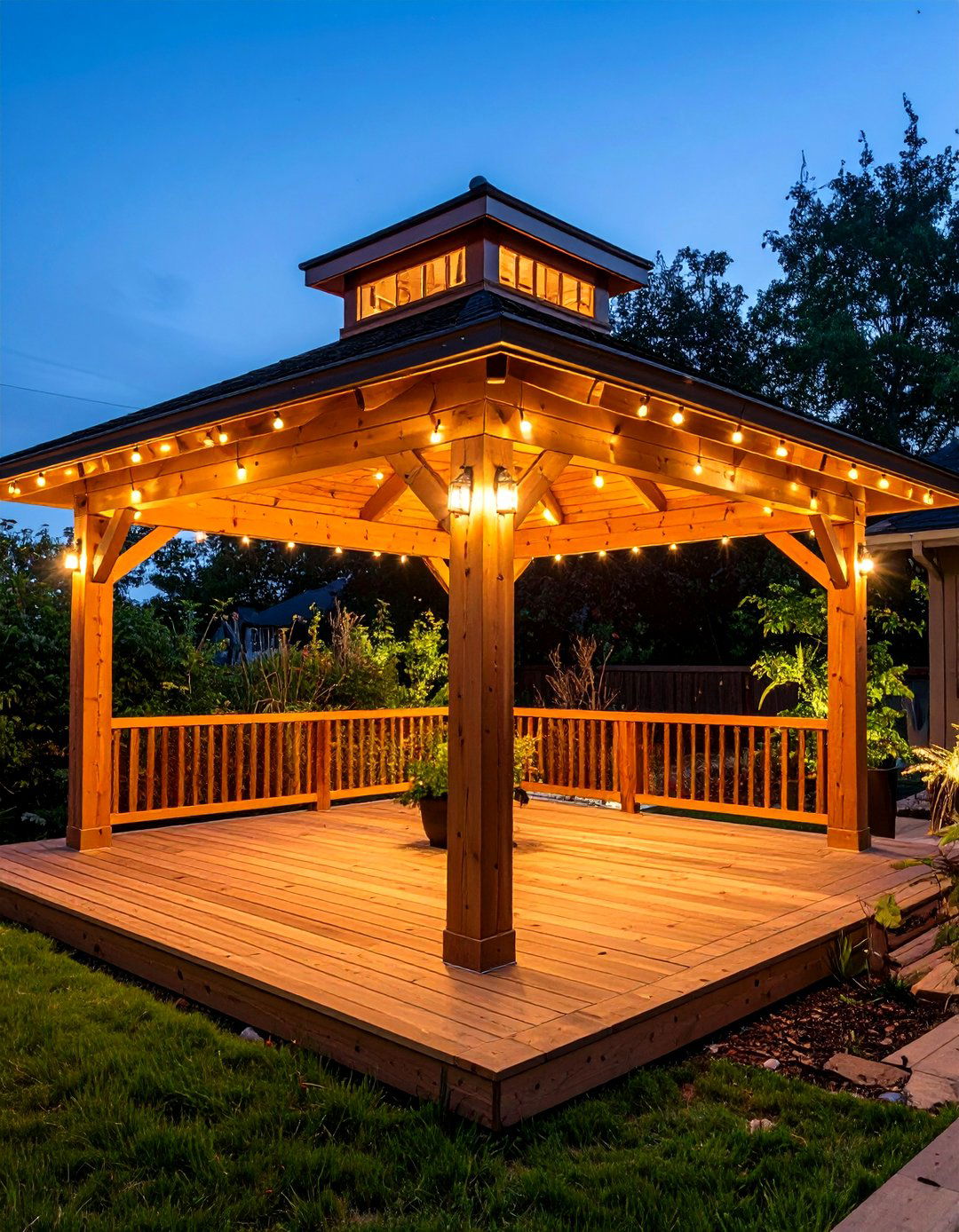
Cedar remains a beloved gazebo material for its aroma, natural rot resistance, and gentle texture under bare feet. A pre-cut cedar kit bolts cleanly to a deck ledger and can be stained any color or left to silver naturally. To highlight grain variation, run concealed LED strip lighting along interior rafters so the canopy glows softly at night. Because cedar accepts screws easily, add custom hooks for hanging plants or hammocks without cracking. Annual oiling restores tone quickly, letting the gazebo age gracefully without high-pressure washing.
8. Floating Deck Gazebo for Challenging Terrain
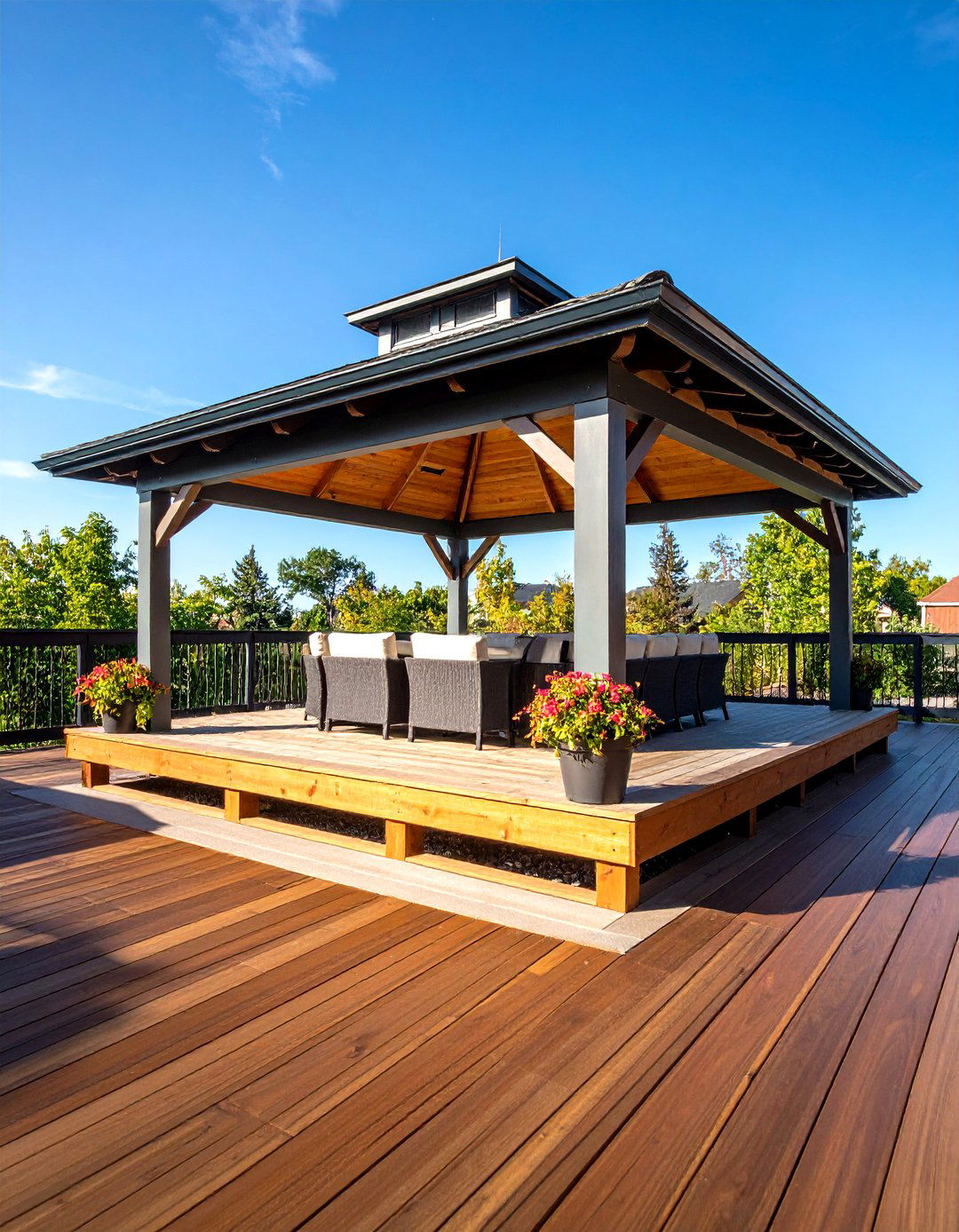
Where uneven or rocky ground makes traditional footings expensive, combine lightweight deck blocks with a freestanding gazebo that “floats” just above grade. Tuff-style polymer blocks accept 4×4 posts directly, minimizing digging. Ensure the block grid is dense beneath gazebo corners to handle concentrated roof loads, and fasten diagonal cross-bracing between posts for stiffness. The result is a solid yet movable platform that protects tree roots or septic lines below. Add removable skirting so seasonal critter inspection stays easy.
9. Solar-Panel Roof Gazebo for Energy Savings
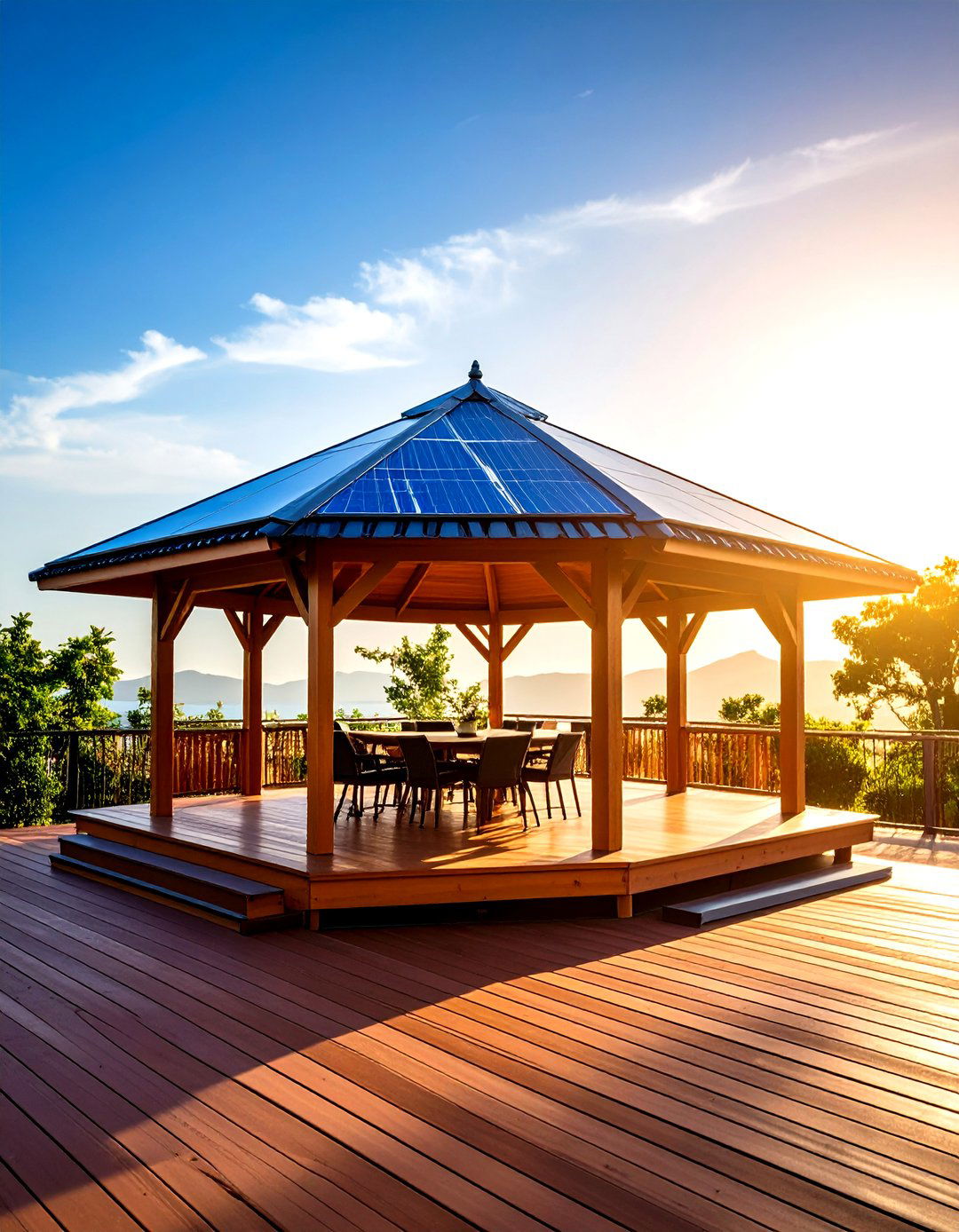
Transform sunlight into deck lighting by swapping a standard hard top for integrated photovoltaic panels. Even a 10×12 ft gazebo roof can host 1 kW of micro-inverters—enough to charge landscape lighting batteries by day and power pathway lights by night. Mount the inverter under the roof ridge to stay shaded and cool, and route conduit through a deck-board chase for a tidy look. Choose tempered glass over polycarbonate panels to withstand hail. The extra weight helps dampen wind sway, doubling as ballast.
10. Pergola-Gazebo Hybrid Shade
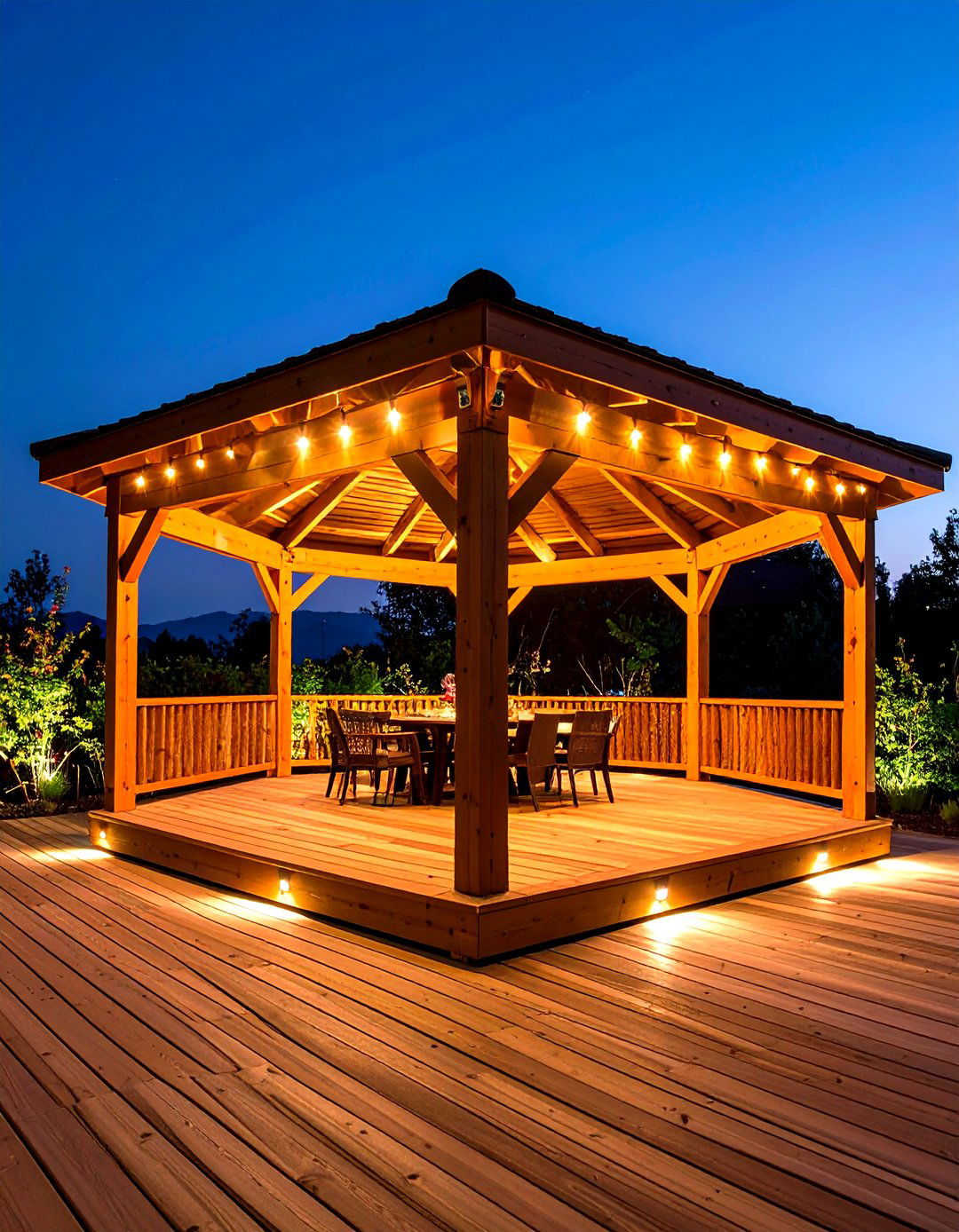
A hybrid mixes the open beams of a pergola with a solid central roof, giving part-sun lounging and full-shade dining in one footprint. Frame 2×8 beams radiating from a square roof core; the lattice ends support vines or retractable canopies. Tongue-and-groove roof decking under the center looks cabin-cozy above a table, while slatted wings keep plantings healthy. LED spotlights line the lattice so shadows dance across the deck at dusk.
11. Mood-Lighting Gazebo for Evening Glow
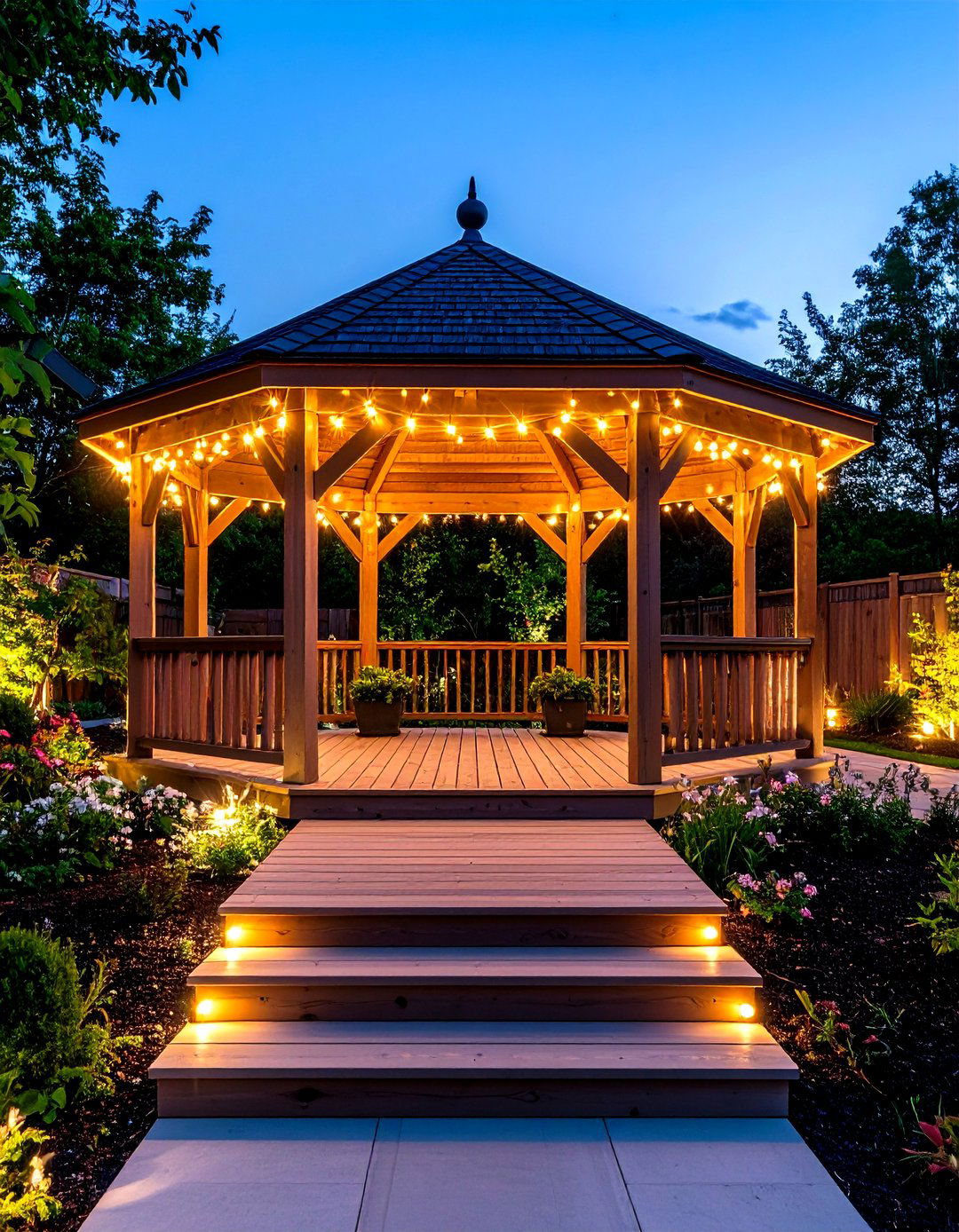
Strategic illumination turns any basic gazebo on deck into a nighttime retreat. Layer soft downlighting from the ridge, warm fairy lights wrapped around perimeter beams, and low-watt step lights along attached deck stairs. Accent lights hidden behind planters highlight rail balusters, extending the glow beyond the roof line without glare. Consider a weatherproof dimmer so settings shift from lively gatherings to candlelike calm. Because LEDs sip power, a small battery and solar panel can run the system off-grid.
12. Garden-Border Gazebo with Built-In Planters
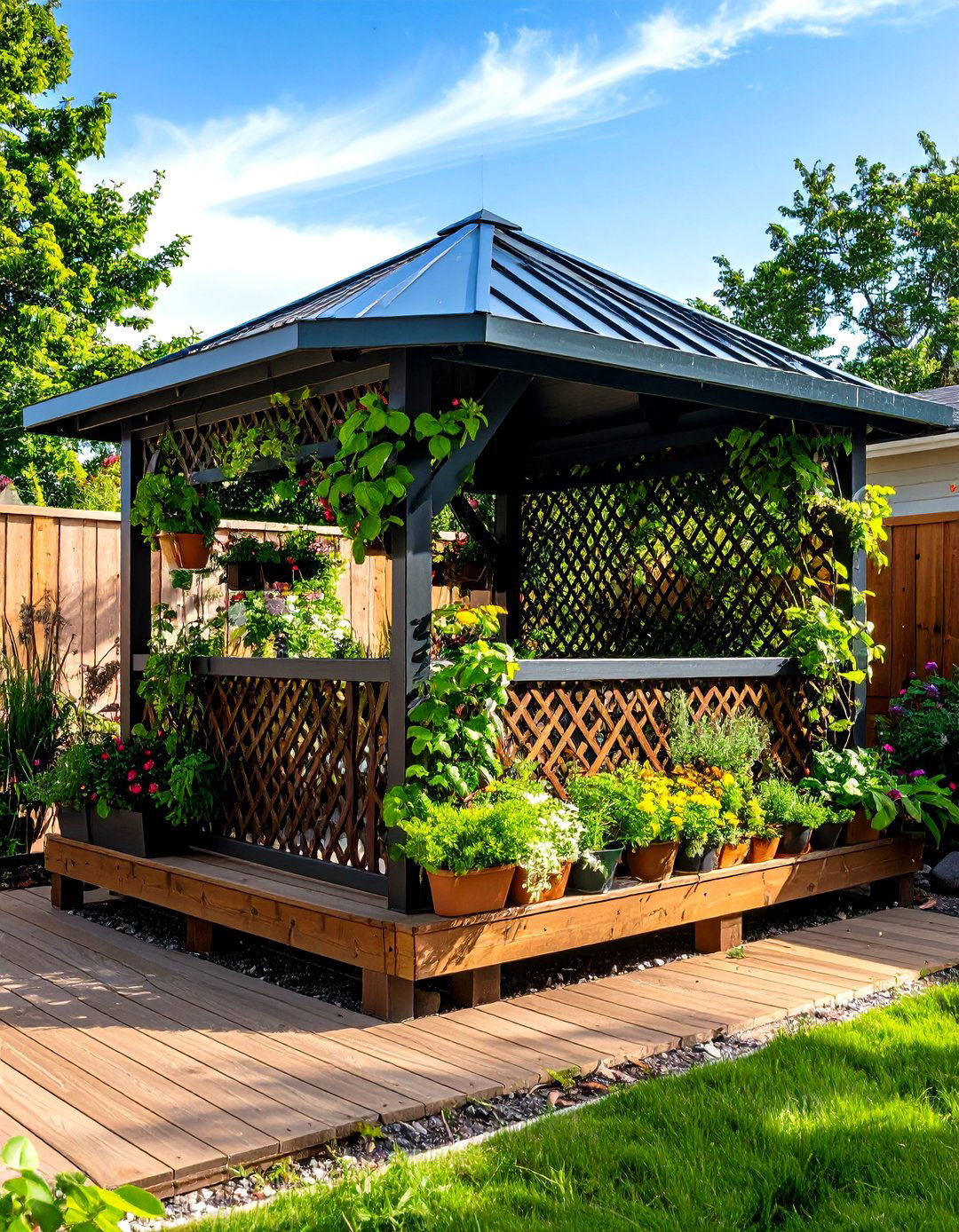
Flank the gazebo sides with integrated, bottomless planters built from matching deck boards; soil rests on the ground so weight stays off decking. Position fragrant herbs along the inner edge so diners catch whiffs of basil or lavender. Tie irrigation into the planter walls using drip tubing clipped behind fascia, keeping hoses unseen. A narrow lattice screen backing each planter grants climbing vines a place to weave, adding shade the first season and floral bursts thereafter.
13. Poolside Deck Gazebo Lounge
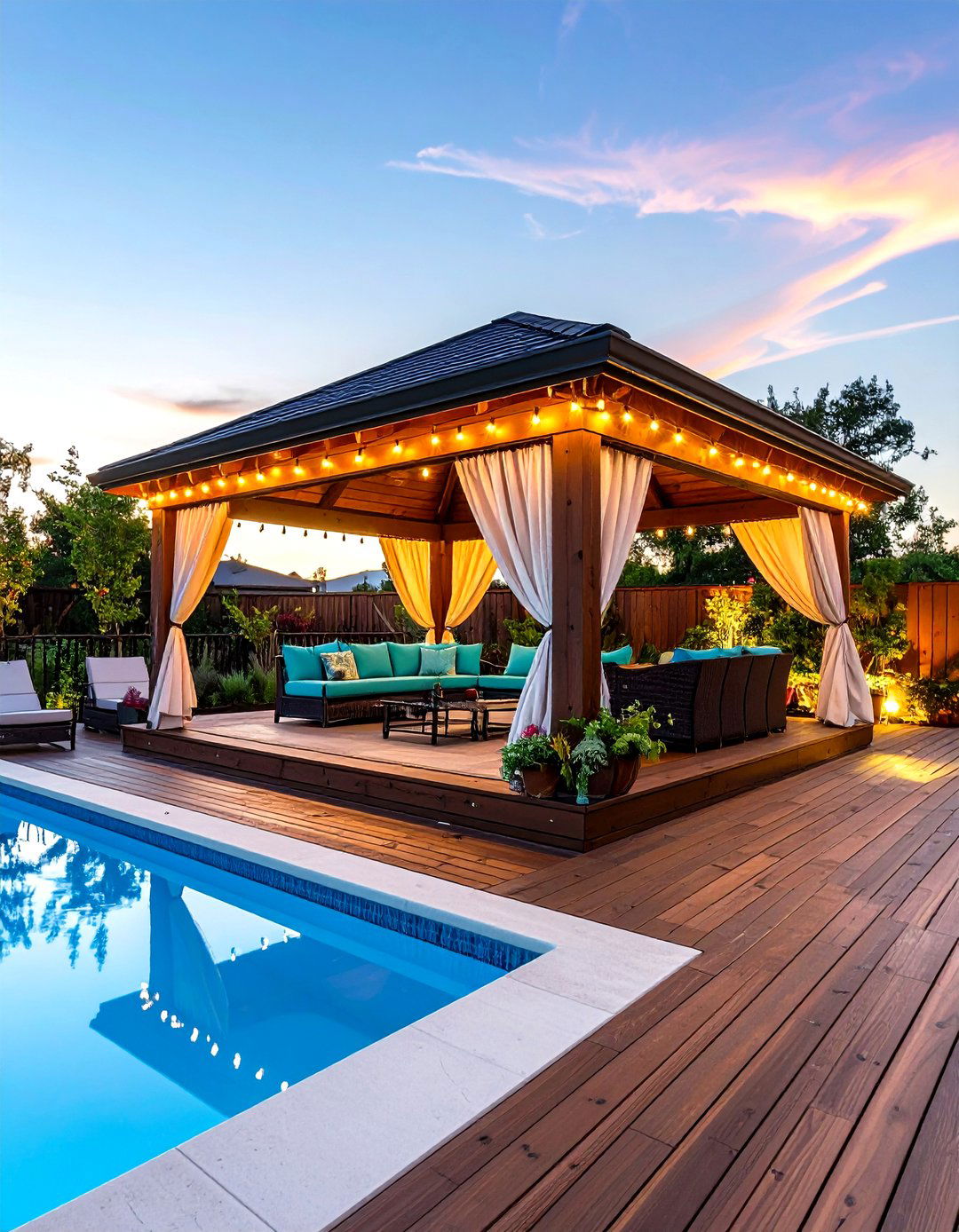
Bringing a gazebo onto a poolline deck adds shade for swimmers and an all-weather snack station. Use slip-resistant, waterproof decking boards inside the gazebo—composite or PVC scoring high on splash zones. Add curtain tracks with quick-dry mesh panels that block midday glare yet dry rapidly. Mount outdoor fans under the roof to vent humidity and help towels dry. Rope lights tucked along the roof fascia ensure safe night swimming without blinding brightness.
14. Rooftop Deck Gazebo Urban Escape

City dwellers can reclaim unused roof space by installing a lightweight aluminum gazebo on pedestal-supported deck tiles. Check local load ratings; aluminum keeps the weight under common 40 lb/ft² limits. Bolt the frame to hidden steel plates so wind can’t lift it. Plant dwarf evergreens in tall planters upwind to diffuse gusts and craft a pocket of calm. A retractable fabric shade on two sides shields against neighboring high-rises without violating setback codes.
15. Circular Fire-Pit Gazebo Gathering Zone
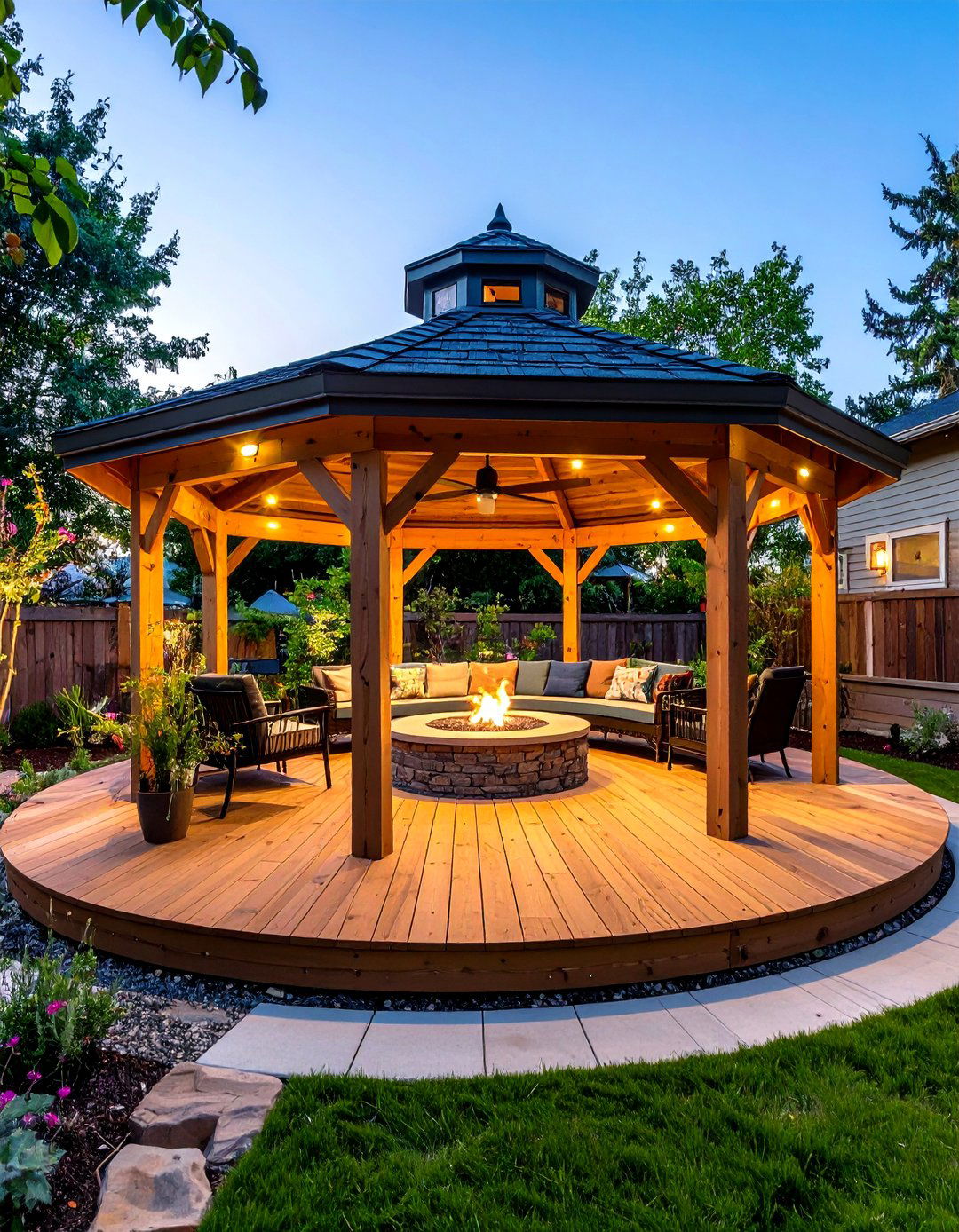
Frame a round deck extension off the main platform, then crown it with an octagonal gazebo so the roof echoes the circle below. Inset a CSA-approved gas fire-pit table at the center; run the gas line beneath removable deck hatches for inspection access. Ceiling-mounted fans keep smoke away while integrated eaves lighting provides marshmallow-roast brightness. Use stone look-alike porcelain pavers under the pit for heat resistance without heavy concrete.
16. Four-Season Gazebo with Insulated Panels

Upgrade a standard hard-top with sandwich roof panels containing rigid insulation; they mute rain roar and keep heat under control in midsummer. Clip-in polycarbonate wall kits enclose the gazebo on cool evenings, effectively converting it into a sunroom. Add a slim electric heater and weather-sealed outlet so the deck remains usable even when temperatures dip toward freezing. Clear panels store flat beneath the deck in summer.
17. Family-Friendly Play-View Gazebo
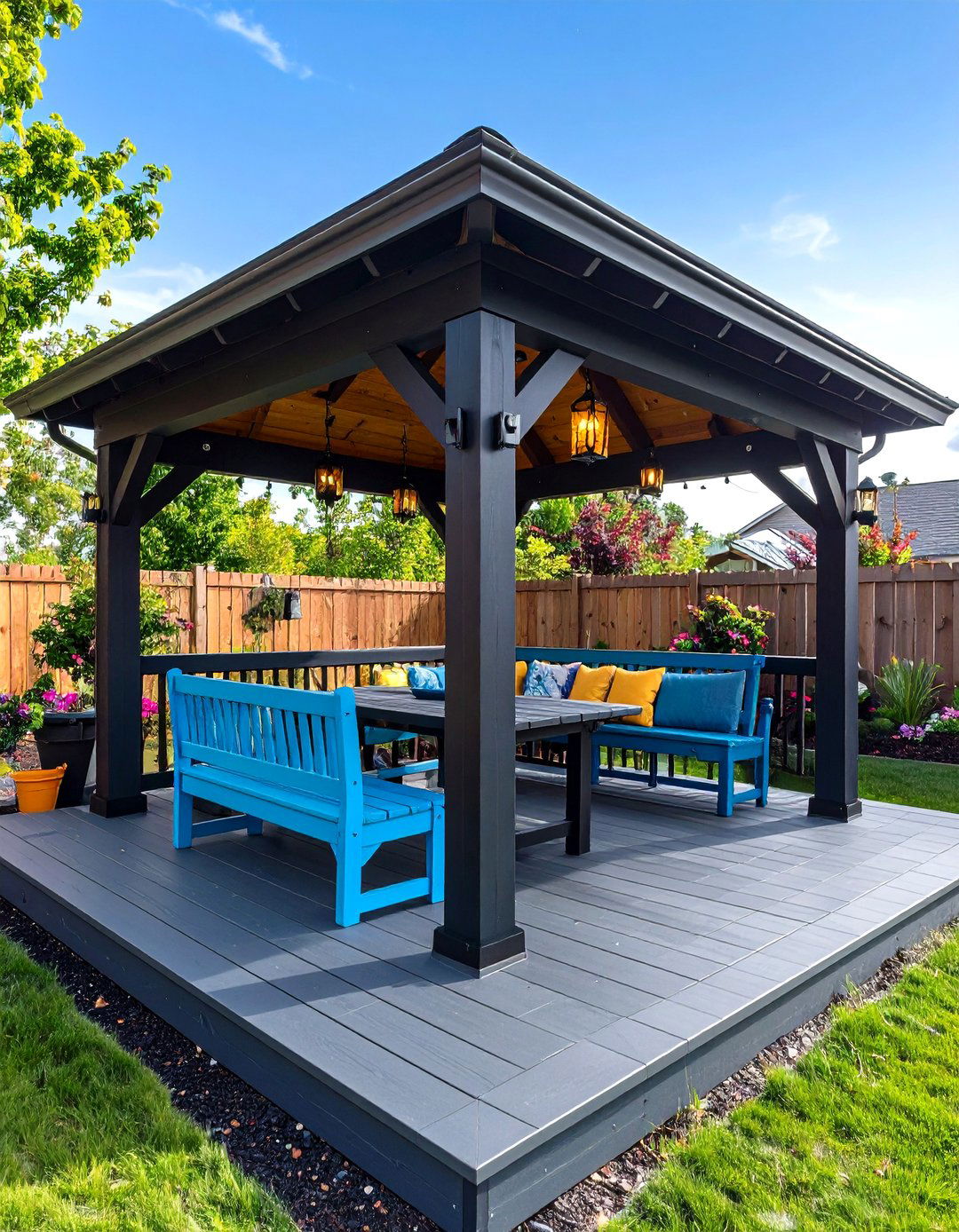
Parents can supervise backyard play from shaded comfort by situating the gazebo to face swing sets or sandboxes. Bench seating with lift-up lids hides toys, while a corner of the deck extends as a chalkboard wall for creative breaks. Choose rounded post caps and balusters spaced under four inches to meet safety codes for little climbers. Rechargeable lanterns secured with magnetic bases avoid cord trip hazards yet move easily for board-game nights.
18. Low-Maintenance Composite Deck Gazebo
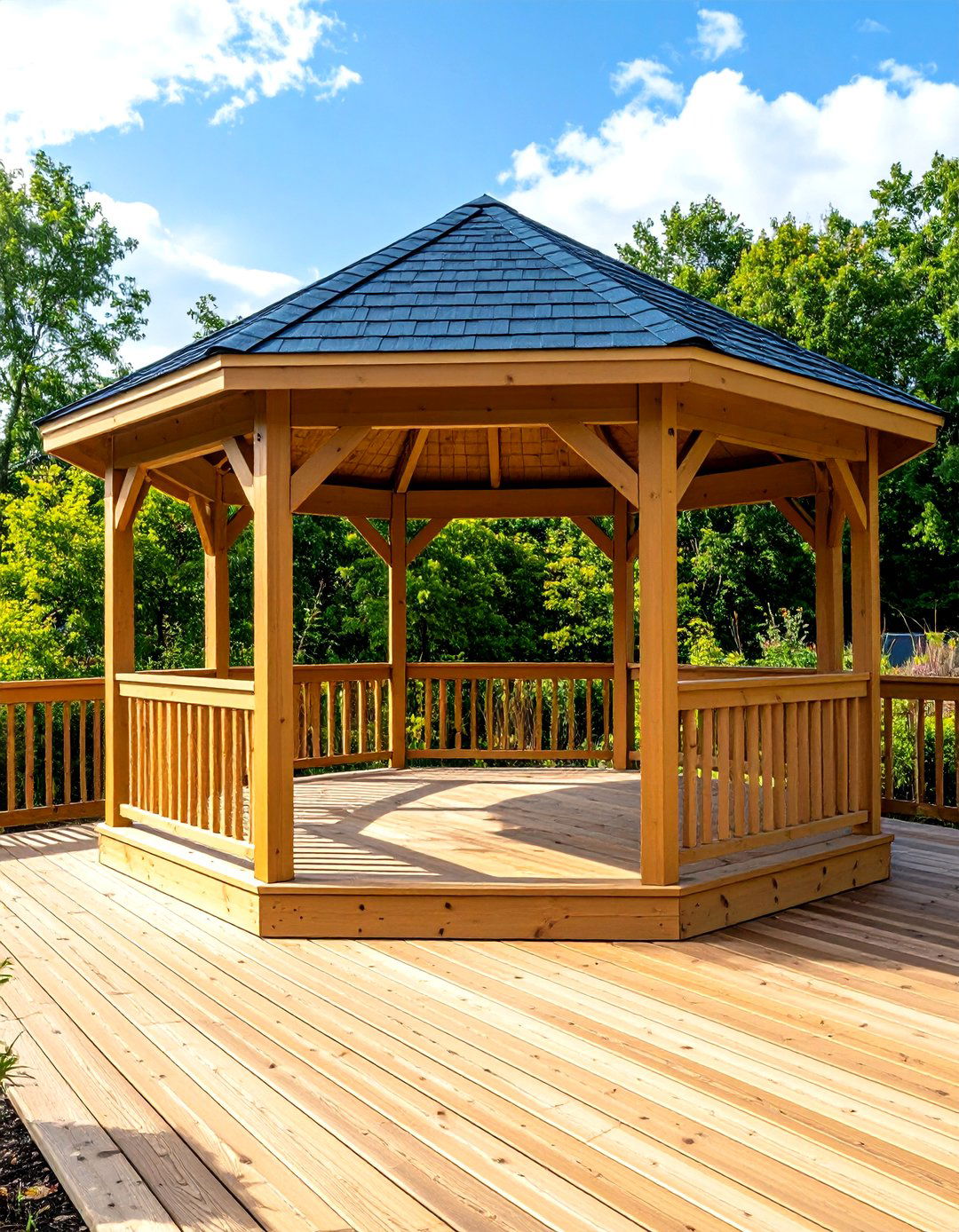
Composite boards under a gazebo shrug off foot traffic, pollen, and iced-tea spills with a simple hose-down. When paired with aluminum posts, the entire structure resists insects and never needs staining—ideal for rental properties or busy families. Fasten boards with hidden clips so expansion gaps stay even under the shade, and match the gazebo roof color to the board streaking for a custom designer look without bespoke cost.
19. Open-Air Dining Gazebo with Outdoor Kitchen
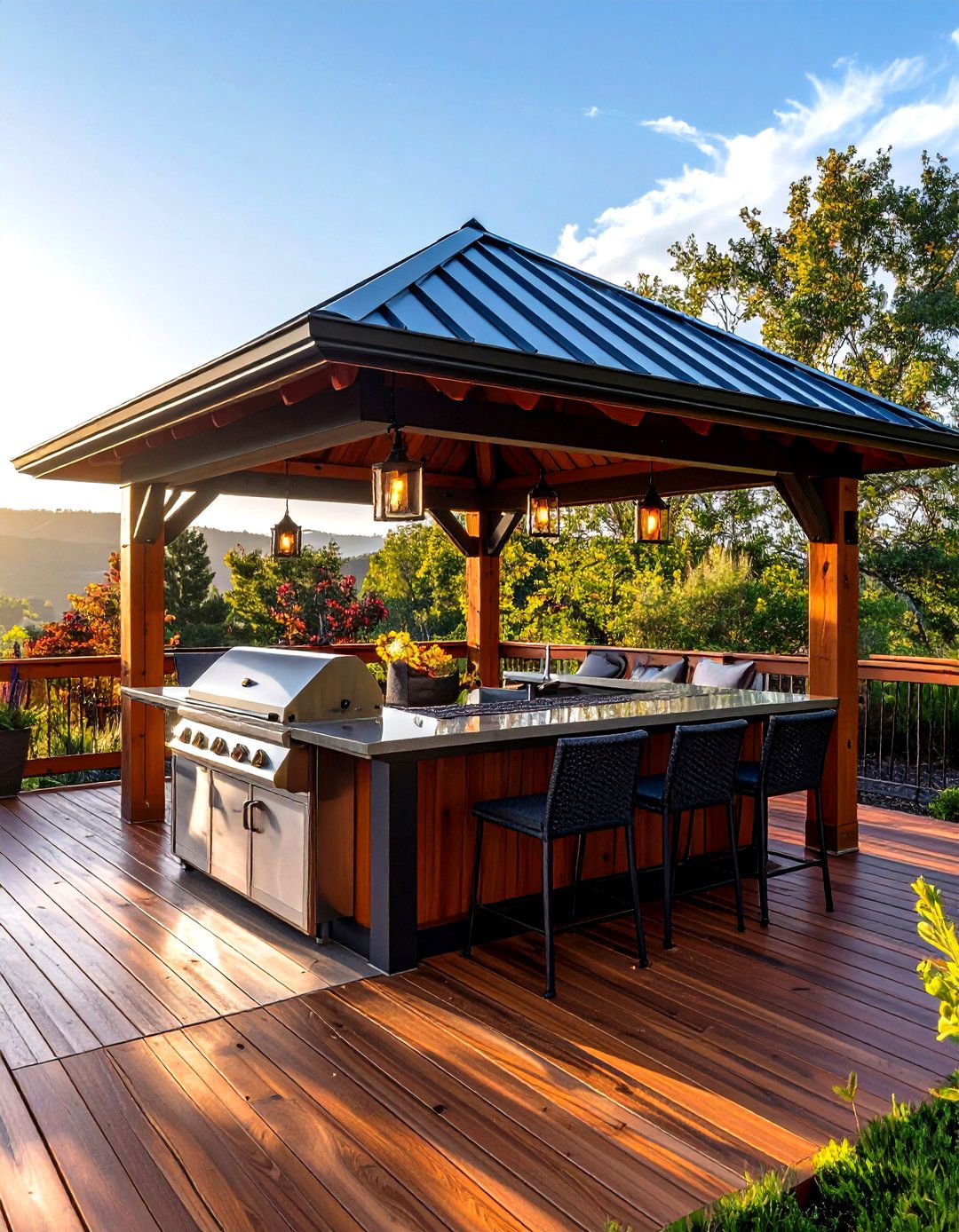
Dedicate one end of the deck to a gazebo fitted with a stainless grill island and fold-down counter leaves. A standing-seam metal roof vents smoke upward, while a narrow skylight strip brightens meal prep during daylight. Run electrical conduits through gazebo posts to power mini-fridges or blenders without exposed cords across decking. At night, pendant fixtures over the table concentrate light on plates, leaving the surrounding deck relaxed and dim.
20. Zen Minimalist Gazebo for Mindful Relaxation

Finally, embrace quiet with a stripped-back gazebo: slim posts, flat low-pitch roof, and uncluttered deck below holding only a meditation cushion or yoga mat. Choose neutral composite decking in stone gray; the cool tone calms. Slatted cedar privacy walls on two sides frame the view like a picture, encouraging focus while blocking wind. A single dimmable lantern hangs from the center beam, its warm glow reflected in a shallow tabletop water bowl.
Conclusion:
Whether you crave a family splash zone, energy-smart roof, or meditative hideaway, these twenty gazebo-on-deck ideas prove that the humble shelter can evolve into an all-season powerhouse. Mixing time-tested cedar, resilient steel, thoughtful lighting layers, and adaptable privacy elements lets you tailor shade, style, and durability precisely to your lifestyle—so your deck becomes the favorite “room” of the house, no matter the weather overhead.




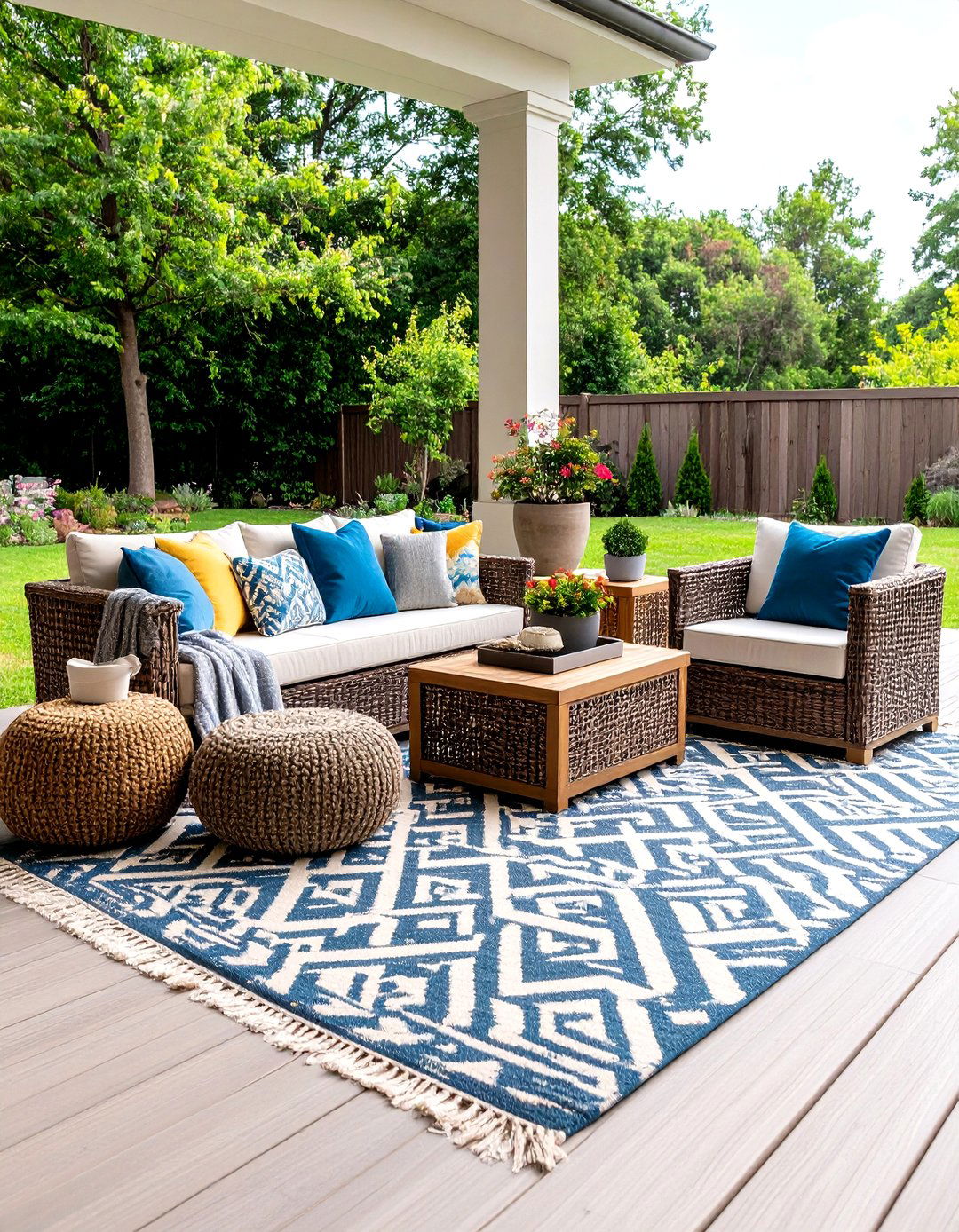
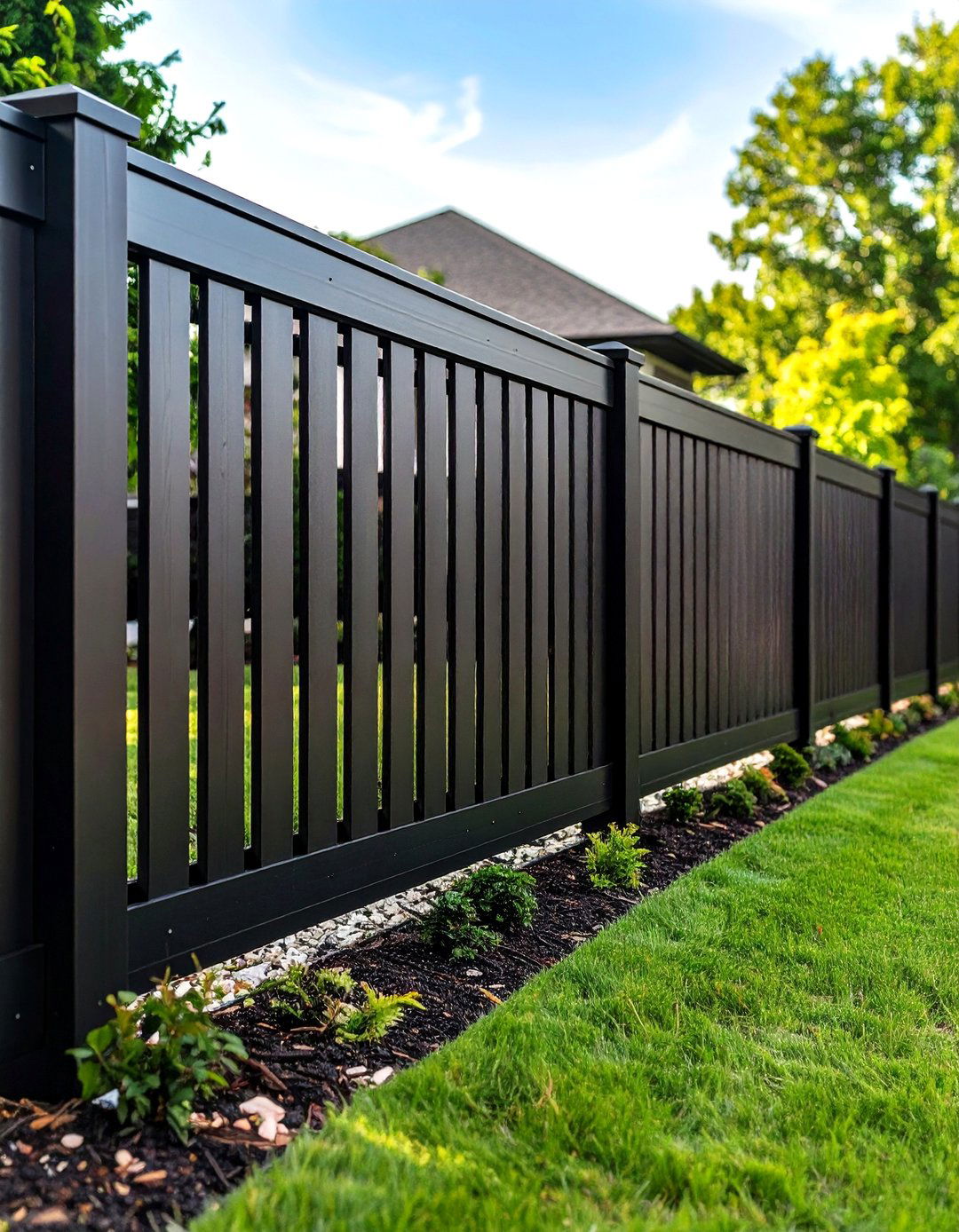
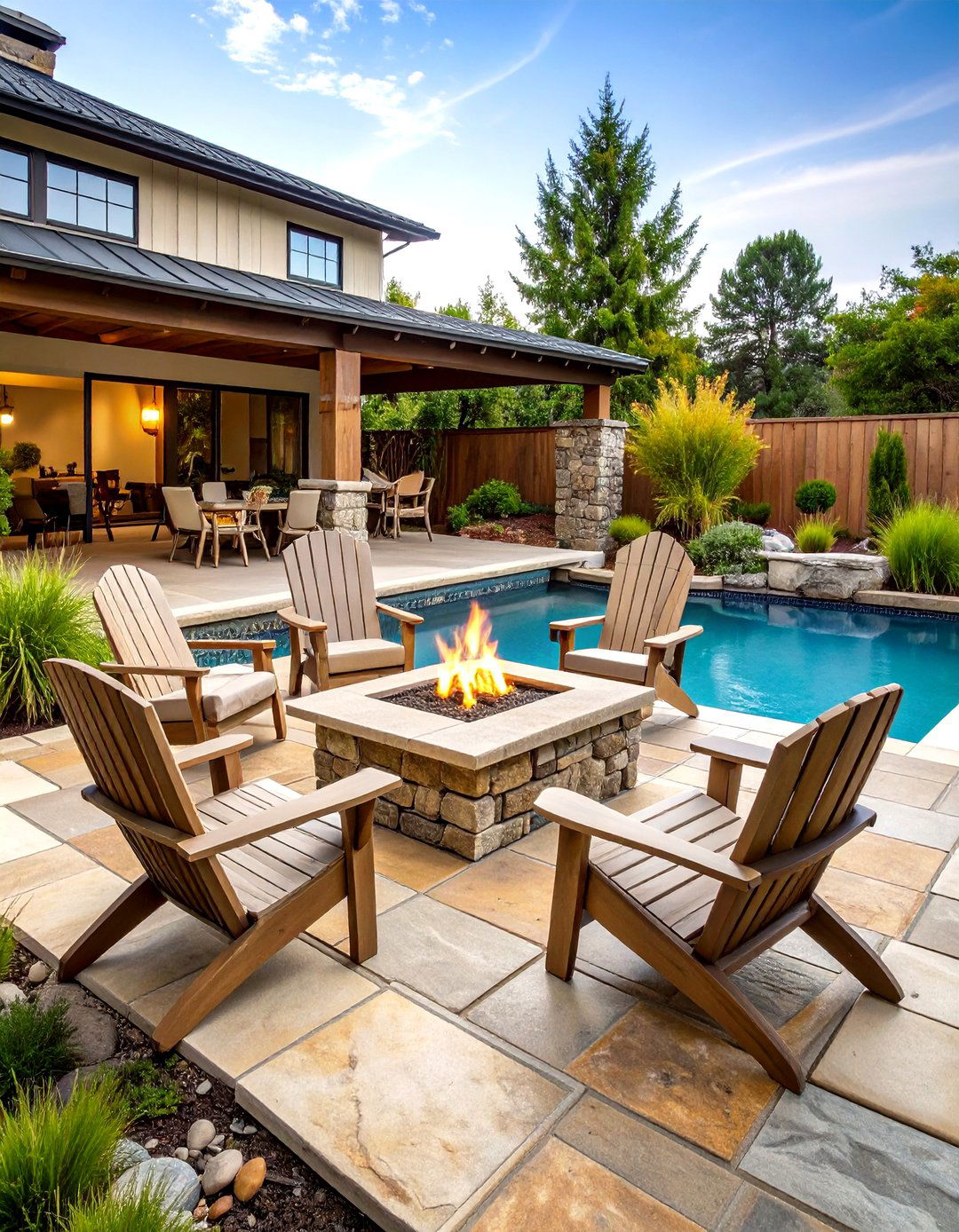
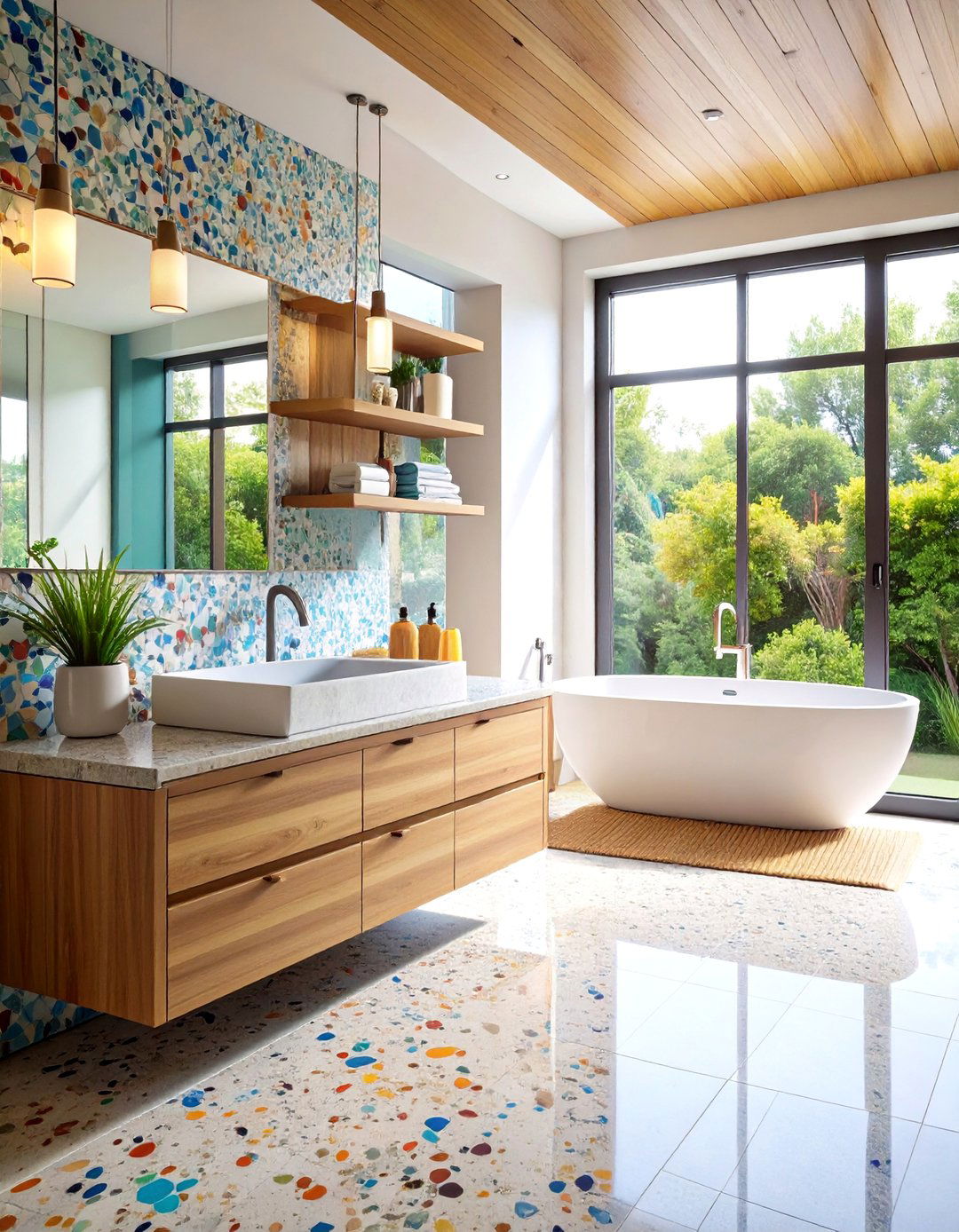
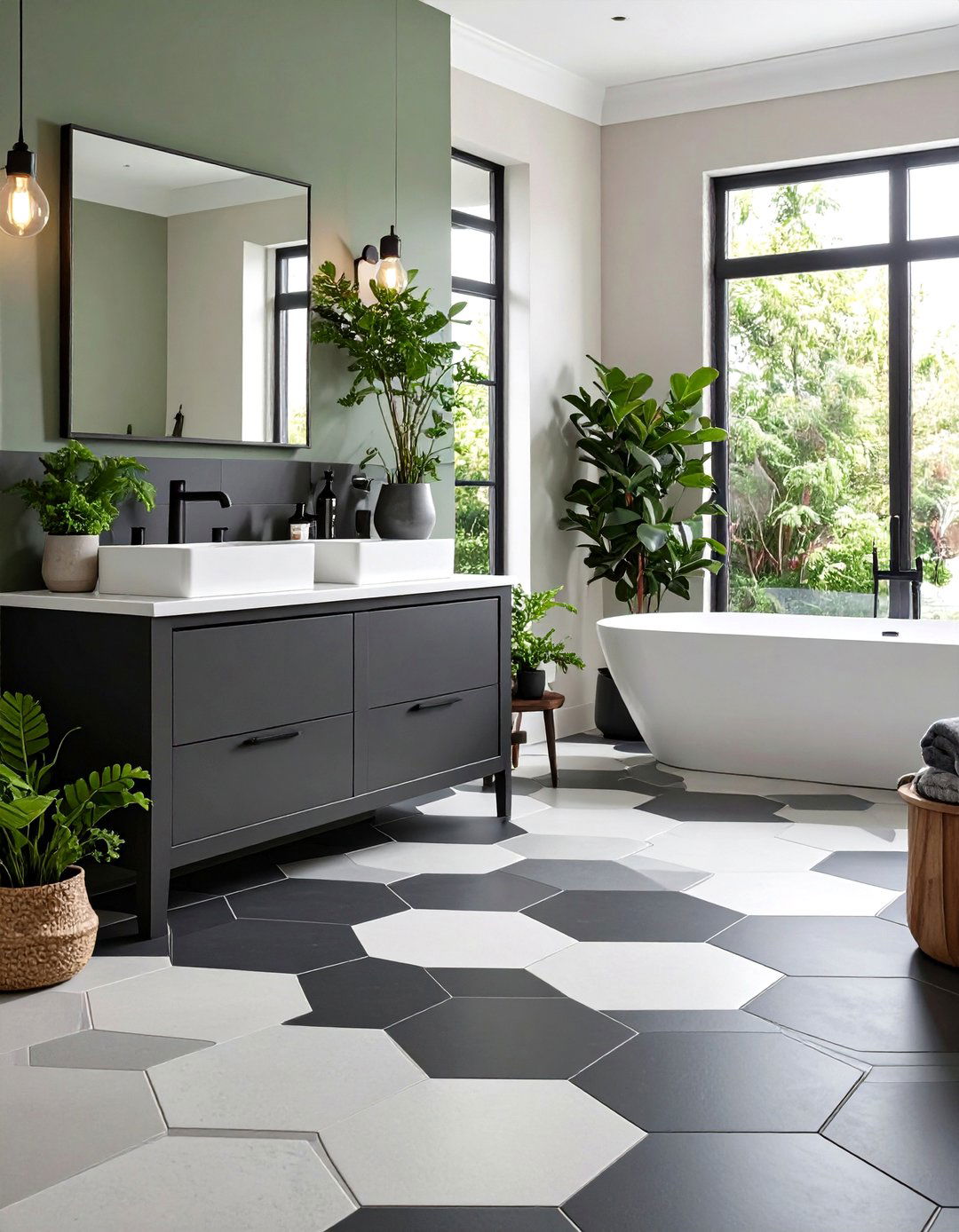


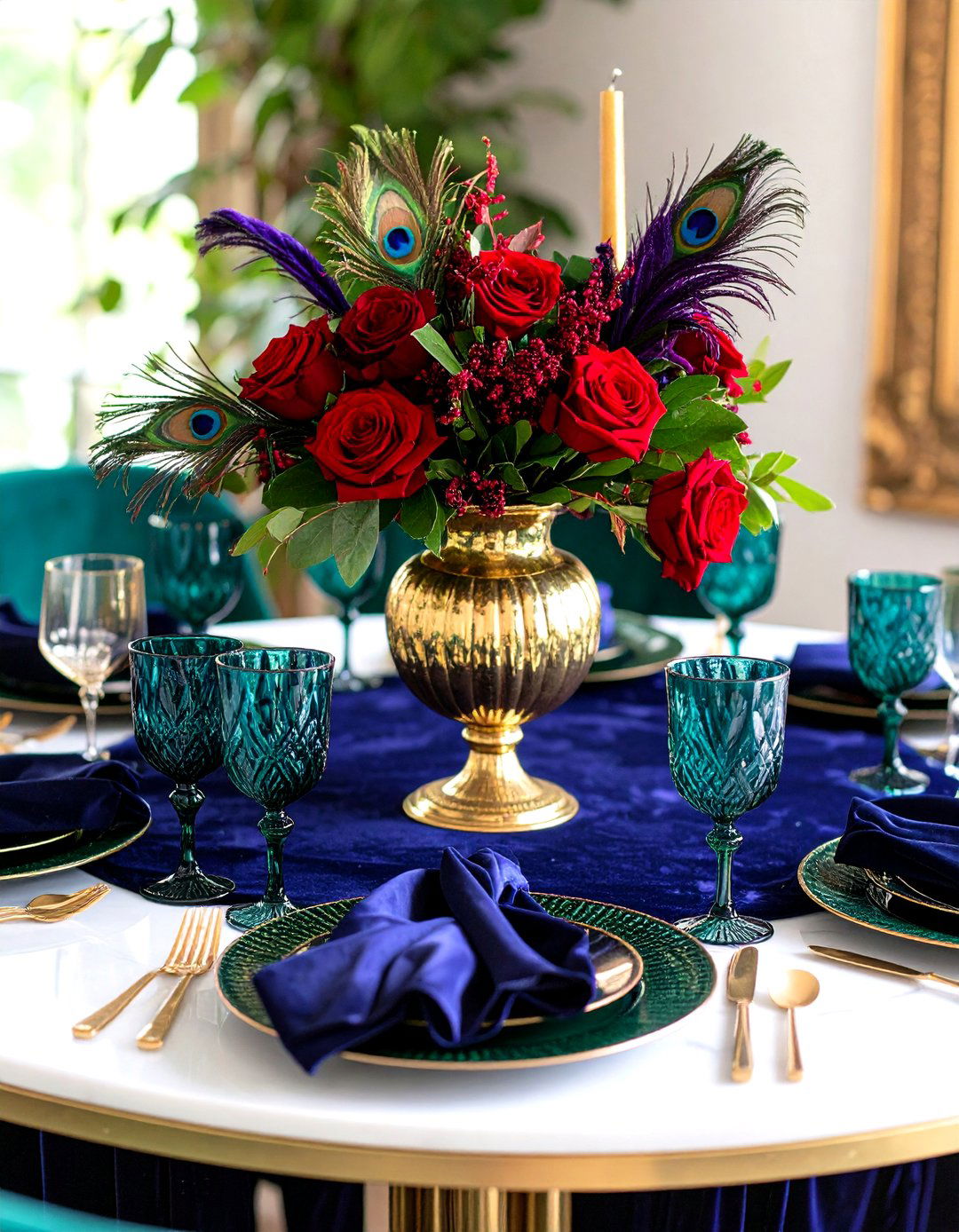
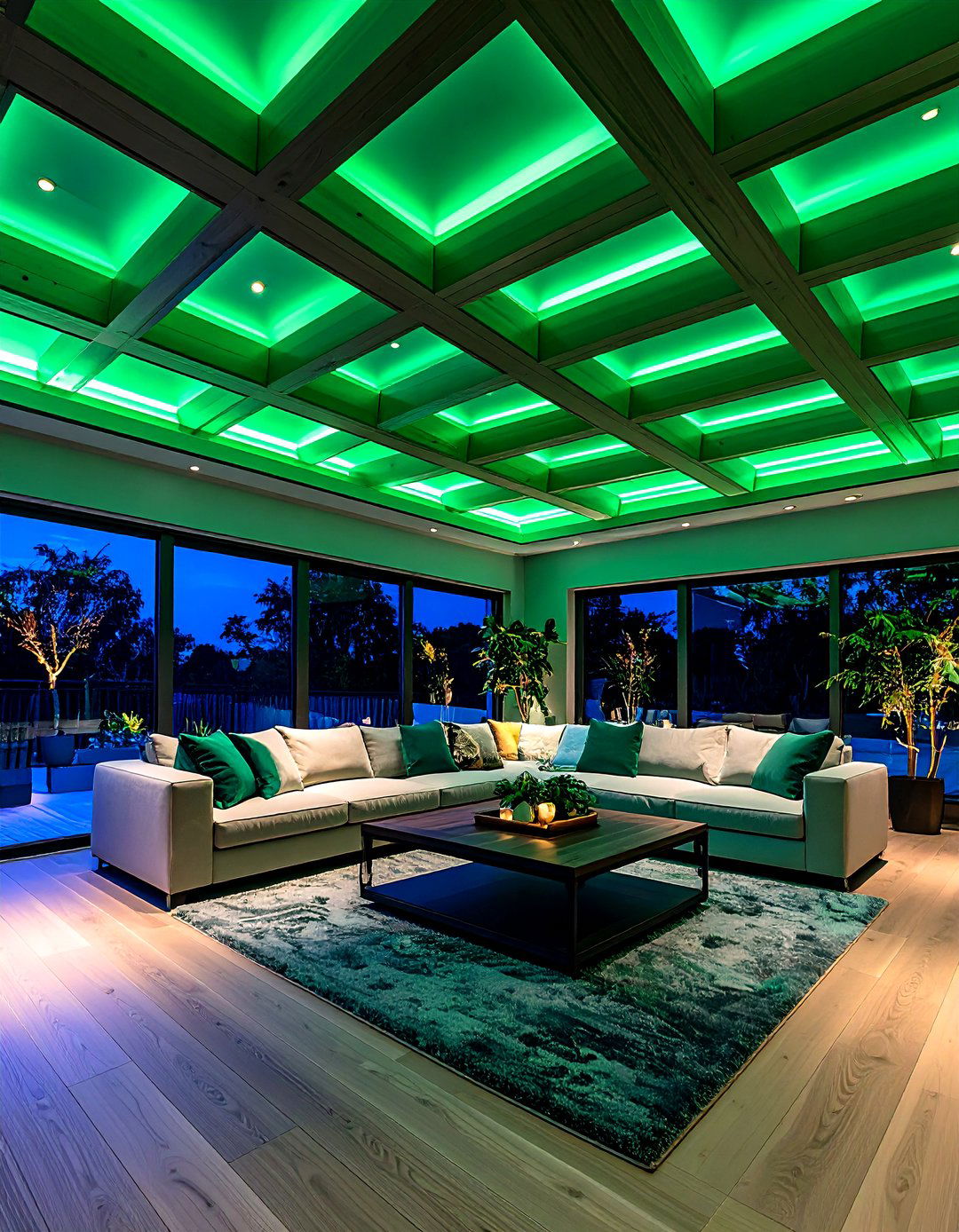
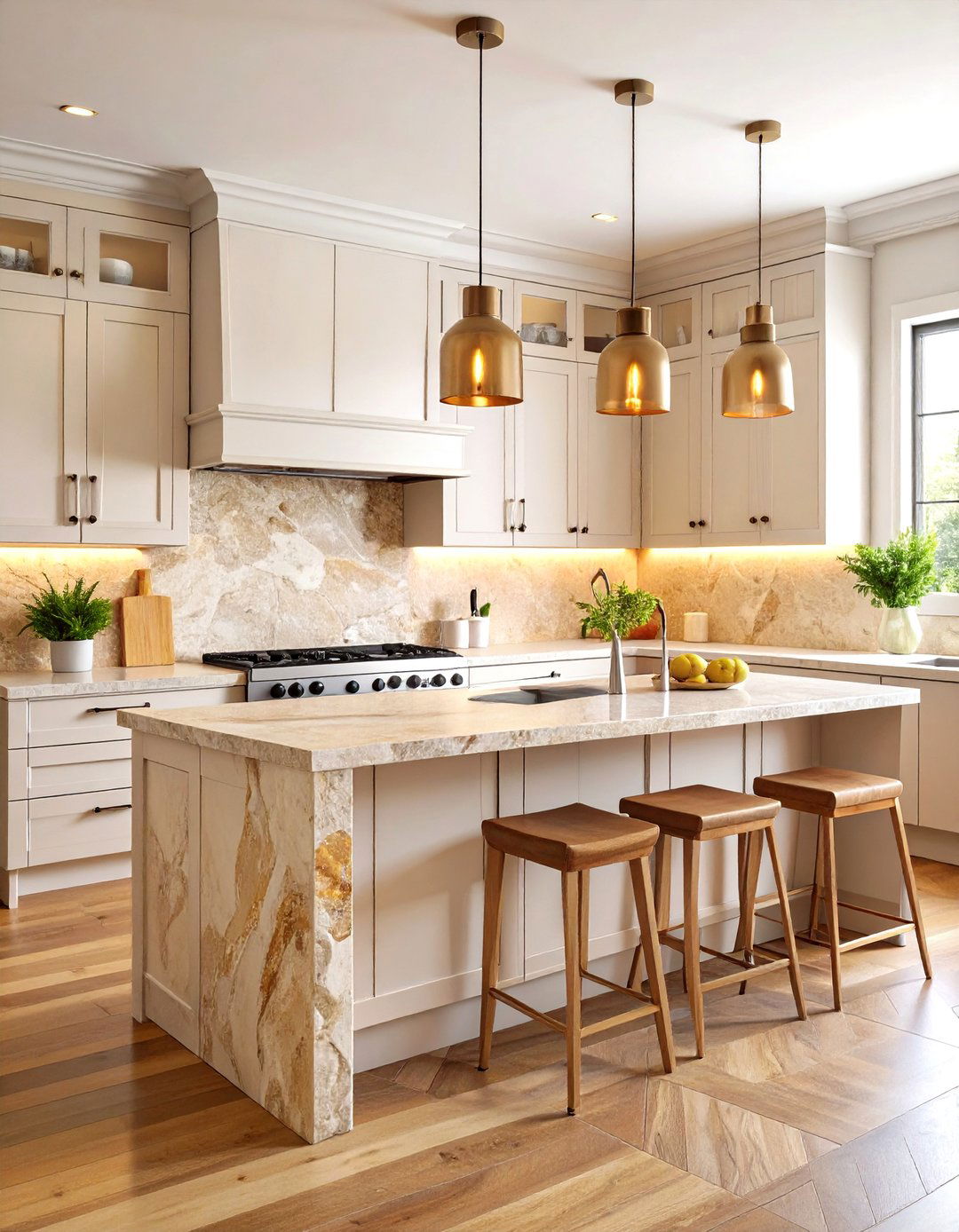
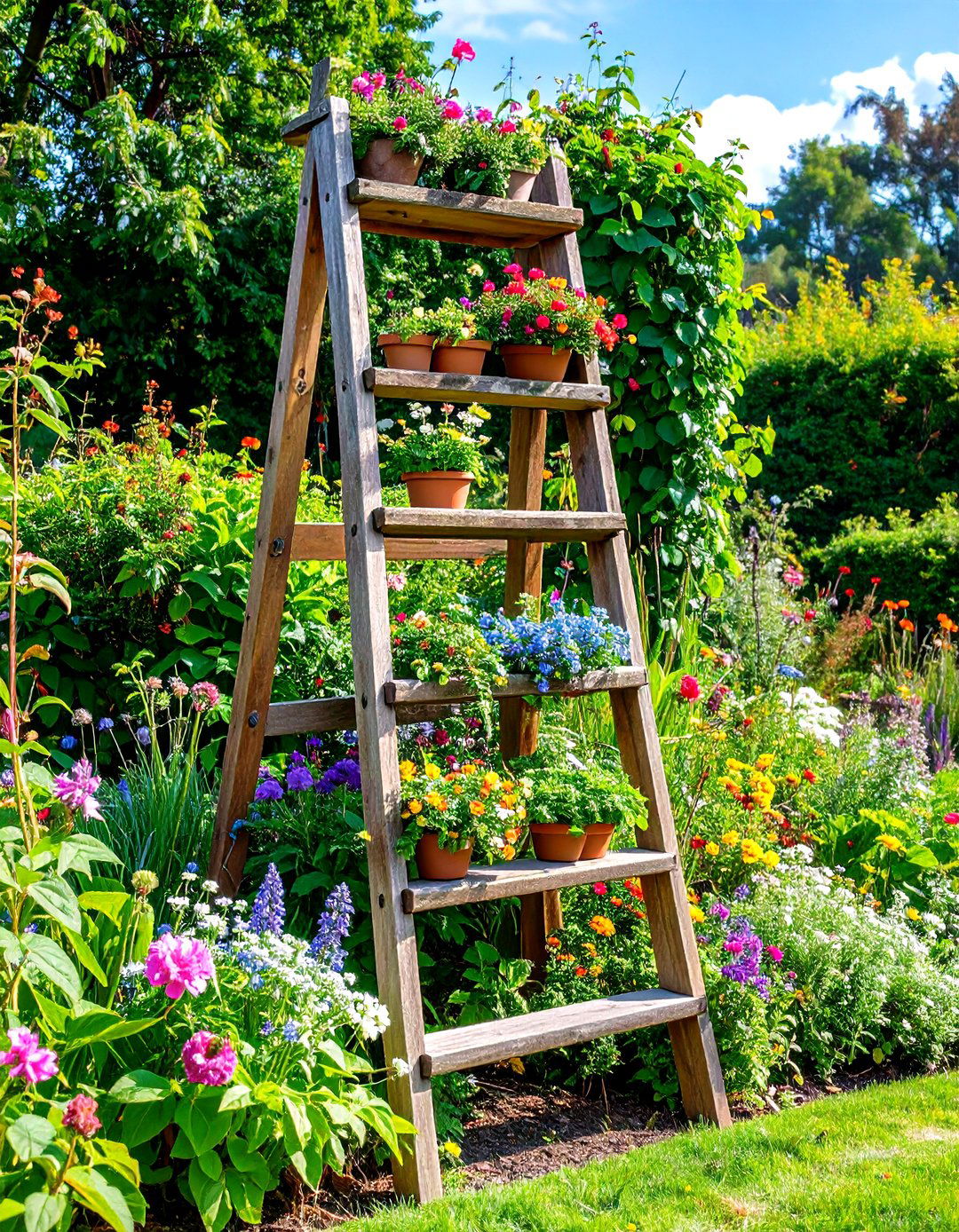
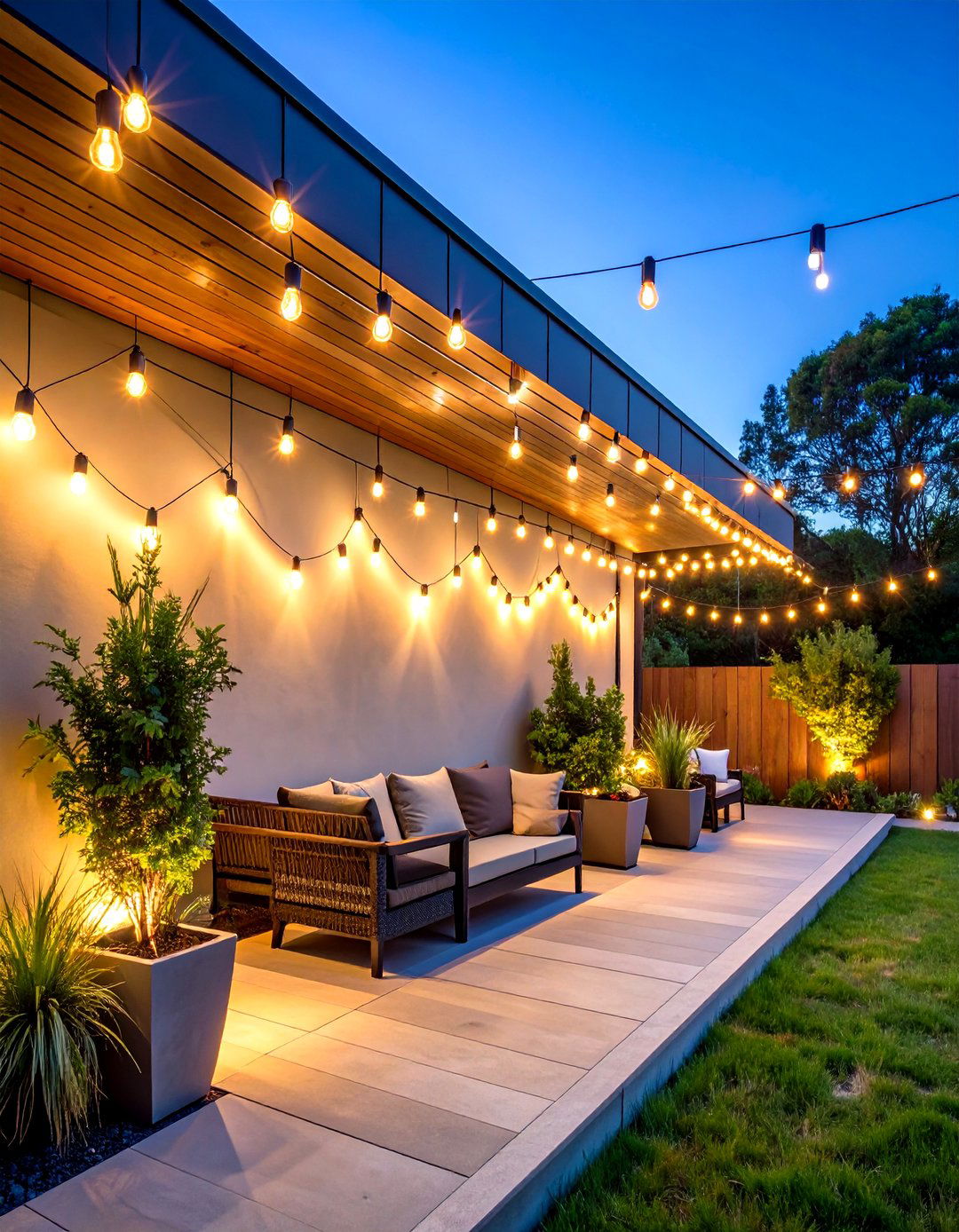
Leave a Reply